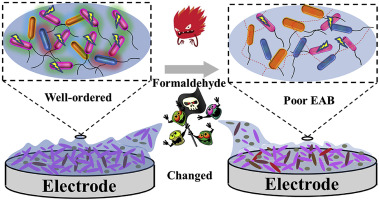当前位置:
X-MOL 学术
›
Environ. Res.
›
论文详情
Our official English website, www.x-mol.net, welcomes your
feedback! (Note: you will need to create a separate account there.)
Unignorable toxicity of formaldehyde on electroactive bacteria in bioelectrochemical systems.
Environmental Research ( IF 7.7 ) Pub Date : 2020-01-17 , DOI: 10.1016/j.envres.2020.109143 Tian Li 1 , Fan Chen 1 , Qixing Zhou 1 , Xin Wang 1 , Chengmei Liao 1 , Lean Zhou 1 , Lili Wan 1 , Jingkun An 2 , Yuxuan Wan 1 , Nan Li 2
Environmental Research ( IF 7.7 ) Pub Date : 2020-01-17 , DOI: 10.1016/j.envres.2020.109143 Tian Li 1 , Fan Chen 1 , Qixing Zhou 1 , Xin Wang 1 , Chengmei Liao 1 , Lean Zhou 1 , Lili Wan 1 , Jingkun An 2 , Yuxuan Wan 1 , Nan Li 2
Affiliation

|
Formaldehyde poses significant threats to the ecosystem and is widely used as a toxicity indicator to obtain electrical signal feedback in electroactive biofilm (EAB)-based sensors. Although many optimizations have been adopted to improve the performance of EAB to formaldehyde, nearly no studies have discussed the toxicity of formaldehyde to EAB. Here, EABs were acclimated with a stable current density (8.9 ± 0.2 A/m2) and then injected with formaldehyde. The current density decreased by 27% and 98% after the injection of 1 and 10 ppm formaldehyde, respectively, compared with that in the control. The ecotoxicity of formaldehyde caused the irreversible loss of current with 3% (1 ppm) and 81% (10 ppm). Confocal laser scanning microscopy and scanning electron microscopy results showed that the redox activity was inhibited by formaldehyde, and the number of dead/broken cells increased from 2% to 40% (1 ppm) and 91% (10 ppm). The contents of the total protein and extracellular polymer substances decreased by more than 28% (1 ppm) and 75% (10 ppm) because of the cleavage reaction caused by formaldehyde. Bacterial community analysis showed that the proportion of Geobacter decreased from 81% to 53% (1 ppm) and 24% (10 ppm). As a result, the current production was significantly impaired, and the irreversible loss increased. Toxicological analysis demonstrated that formaldehyde disturbed the physiological indices of cells, thereby inducing apoptosis. These findings fill the gap of ecotoxicology of toxicants to EAB in a bioelectrochemical system.
中文翻译:

甲醛对生物电化学系统中电活性细菌的不可忽视的毒性。
甲醛对生态系统构成重大威胁,并广泛用作毒性指示剂,以在基于电活性生物膜(EAB)的传感器中获得电信号反馈。尽管已采取许多优化措施来改善EAB对甲醛的性能,但几乎没有研究讨论甲醛对EAB的毒性。在这里,EAB以稳定的电流密度(8.9±0.2 A / m2)适应环境,然后注入甲醛。与对照组相比,注入1 ppm和10 ppm甲醛后,电流密度分别降低了27%和98%。甲醛的生态毒性导致不可逆的电流损失,分别为3%(1 ppm)和81%(10 ppm)。共聚焦激光扫描显微镜和扫描电子显微镜结果表明,甲醛抑制了氧化还原活性,死亡/破裂细胞的数量从2%增加到40%(1 ppm)和91%(10 ppm)。由于甲醛引起的裂解反应,总蛋白和细胞外聚合物物质的含量降低了28%(1 ppm)和75%(10 ppm)以上。细菌群落分析表明,土壤杆菌的比例从81%降至53%(1 ppm)和24%(10 ppm)。结果,当前的生产大大受损,不可逆损失增加。毒理学分析表明甲醛会干扰细胞的生理指标,从而诱导细胞凋亡。这些发现填补了生物电化学系统中毒物对EAB的生态毒理学空白。由于甲醛引起的裂解反应,总蛋白和细胞外聚合物物质的含量降低了28%(1 ppm)和75%(10 ppm)以上。细菌群落分析表明,土壤杆菌的比例从81%降至53%(1 ppm)和24%(10 ppm)。结果,当前的生产大大受损,不可逆损失增加。毒理学分析表明甲醛会干扰细胞的生理指标,从而诱导细胞凋亡。这些发现填补了生物电化学系统中毒物对EAB的生态毒理学空白。由于甲醛引起的裂解反应,总蛋白和细胞外聚合物物质的含量降低了28%(1 ppm)和75%(10 ppm)以上。细菌群落分析表明,土壤杆菌的比例从81%降至53%(1 ppm)和24%(10 ppm)。结果,当前的生产大大受损,不可逆损失增加。毒理学分析表明甲醛会干扰细胞的生理指标,从而诱导细胞凋亡。这些发现填补了生物电化学系统中毒物对EAB的生态毒理学空白。结果,当前的生产大大受损,不可逆损失增加。毒理学分析表明甲醛会干扰细胞的生理指标,从而诱导细胞凋亡。这些发现填补了生物电化学系统中毒物对EAB的生态毒理学空白。结果,当前的生产大大受损,不可逆损失增加。毒理学分析表明甲醛会干扰细胞的生理指标,从而诱导细胞凋亡。这些发现填补了生物电化学系统中毒物对EAB的生态毒理学空白。
更新日期:2020-01-17
中文翻译:

甲醛对生物电化学系统中电活性细菌的不可忽视的毒性。
甲醛对生态系统构成重大威胁,并广泛用作毒性指示剂,以在基于电活性生物膜(EAB)的传感器中获得电信号反馈。尽管已采取许多优化措施来改善EAB对甲醛的性能,但几乎没有研究讨论甲醛对EAB的毒性。在这里,EAB以稳定的电流密度(8.9±0.2 A / m2)适应环境,然后注入甲醛。与对照组相比,注入1 ppm和10 ppm甲醛后,电流密度分别降低了27%和98%。甲醛的生态毒性导致不可逆的电流损失,分别为3%(1 ppm)和81%(10 ppm)。共聚焦激光扫描显微镜和扫描电子显微镜结果表明,甲醛抑制了氧化还原活性,死亡/破裂细胞的数量从2%增加到40%(1 ppm)和91%(10 ppm)。由于甲醛引起的裂解反应,总蛋白和细胞外聚合物物质的含量降低了28%(1 ppm)和75%(10 ppm)以上。细菌群落分析表明,土壤杆菌的比例从81%降至53%(1 ppm)和24%(10 ppm)。结果,当前的生产大大受损,不可逆损失增加。毒理学分析表明甲醛会干扰细胞的生理指标,从而诱导细胞凋亡。这些发现填补了生物电化学系统中毒物对EAB的生态毒理学空白。由于甲醛引起的裂解反应,总蛋白和细胞外聚合物物质的含量降低了28%(1 ppm)和75%(10 ppm)以上。细菌群落分析表明,土壤杆菌的比例从81%降至53%(1 ppm)和24%(10 ppm)。结果,当前的生产大大受损,不可逆损失增加。毒理学分析表明甲醛会干扰细胞的生理指标,从而诱导细胞凋亡。这些发现填补了生物电化学系统中毒物对EAB的生态毒理学空白。由于甲醛引起的裂解反应,总蛋白和细胞外聚合物物质的含量降低了28%(1 ppm)和75%(10 ppm)以上。细菌群落分析表明,土壤杆菌的比例从81%降至53%(1 ppm)和24%(10 ppm)。结果,当前的生产大大受损,不可逆损失增加。毒理学分析表明甲醛会干扰细胞的生理指标,从而诱导细胞凋亡。这些发现填补了生物电化学系统中毒物对EAB的生态毒理学空白。结果,当前的生产大大受损,不可逆损失增加。毒理学分析表明甲醛会干扰细胞的生理指标,从而诱导细胞凋亡。这些发现填补了生物电化学系统中毒物对EAB的生态毒理学空白。结果,当前的生产大大受损,不可逆损失增加。毒理学分析表明甲醛会干扰细胞的生理指标,从而诱导细胞凋亡。这些发现填补了生物电化学系统中毒物对EAB的生态毒理学空白。











































 京公网安备 11010802027423号
京公网安备 11010802027423号